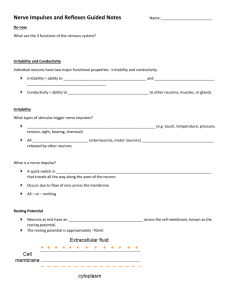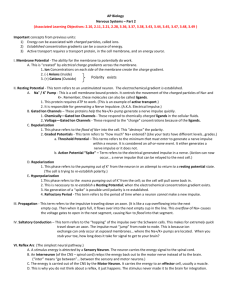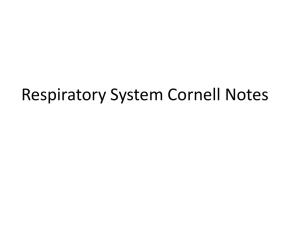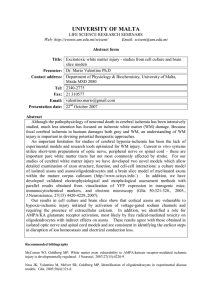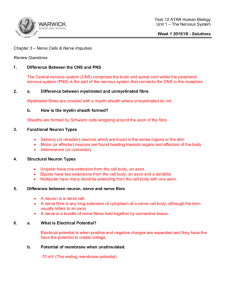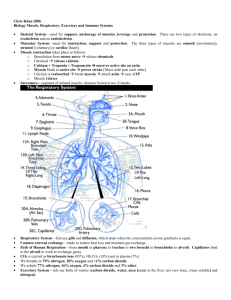Neuroscience 26 Exam 1 Spring, 2010
advertisement
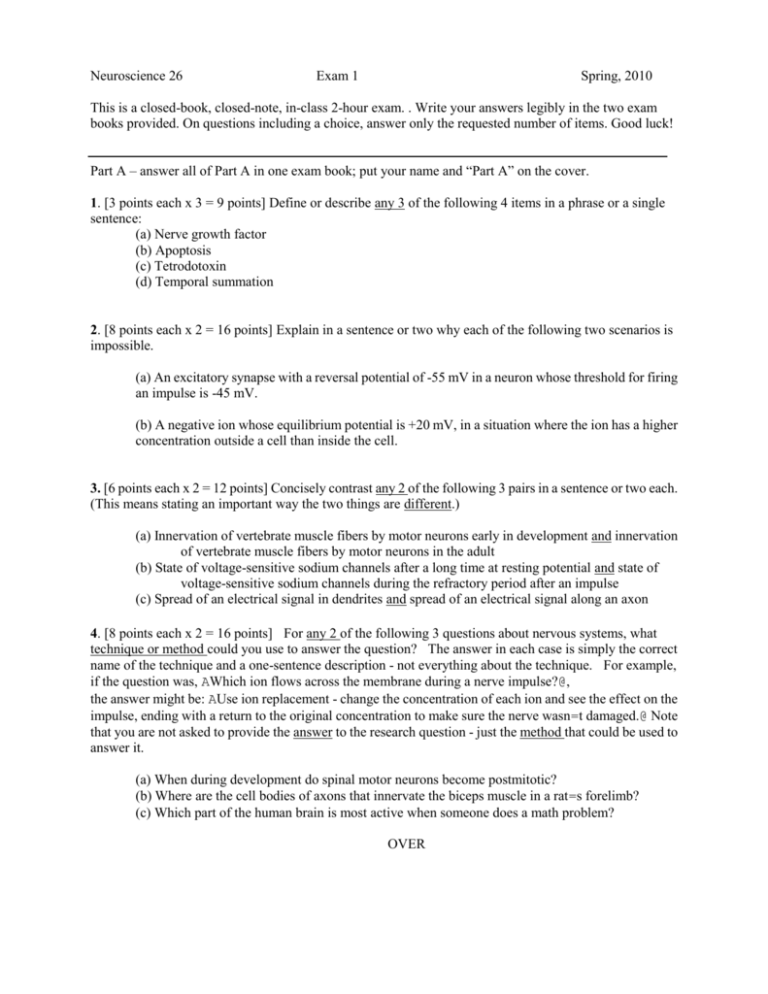
Neuroscience 26 Exam 1 Spring, 2010 This is a closed-book, closed-note, in-class 2-hour exam. . Write your answers legibly in the two exam books provided. On questions including a choice, answer only the requested number of items. Good luck! Part A – answer all of Part A in one exam book; put your name and “Part A” on the cover. 1. [3 points each x 3 = 9 points] Define or describe any 3 of the following 4 items in a phrase or a single sentence: (a) Nerve growth factor (b) Apoptosis (c) Tetrodotoxin (d) Temporal summation 2. [8 points each x 2 = 16 points] Explain in a sentence or two why each of the following two scenarios is impossible. (a) An excitatory synapse with a reversal potential of -55 mV in a neuron whose threshold for firing an impulse is -45 mV. (b) A negative ion whose equilibrium potential is +20 mV, in a situation where the ion has a higher concentration outside a cell than inside the cell. 3. [6 points each x 2 = 12 points] Concisely contrast any 2 of the following 3 pairs in a sentence or two each. (This means stating an important way the two things are different.) (a) Innervation of vertebrate muscle fibers by motor neurons early in development and innervation of vertebrate muscle fibers by motor neurons in the adult (b) State of voltage-sensitive sodium channels after a long time at resting potential and state of voltage-sensitive sodium channels during the refractory period after an impulse (c) Spread of an electrical signal in dendrites and spread of an electrical signal along an axon 4. [8 points each x 2 = 16 points] For any 2 of the following 3 questions about nervous systems, what technique or method could you use to answer the question? The answer in each case is simply the correct name of the technique and a one-sentence description - not everything about the technique. For example, if the question was, AWhich ion flows across the membrane during a nerve impulse?@, the answer might be: AUse ion replacement - change the concentration of each ion and see the effect on the impulse, ending with a return to the original concentration to make sure the nerve wasn=t damaged.@ Note that you are not asked to provide the answer to the research question - just the method that could be used to answer it. (a) When during development do spinal motor neurons become postmitotic? (b) Where are the cell bodies of axons that innervate the biceps muscle in a rat=s forelimb? (c) Which part of the human brain is most active when someone does a math problem? OVER 5. [15 points] Answer either one of the following 2 questions, i.e. either (a) or (b). Suggested length: half a page. (a) In her scientific paper, "Regulation of extracellular potassium in the developing hippocampus," Dr. Janet Stringer reported that the rise in [K+]o following electrical stimulation of the hippocampus was smallest in the youngest animals tested. Recovery from elevated [K+]o was slowest in the youngest animals. The youngest animals had a higher incidence of afterdischarges than older animals. Questions: (i) What condition in humans motivated this research? (ii) What hypothesis regarding this condition was being tested? (iii) Which of the three results listed above, if any, support the hypothesis, and which of the results, if any, don't necessarily support the hypothesis, and why? - OR – (b) In their scientific paper, "Regulation of axon growth in vivo by activity-based competition," Jackie Hua and colleagues used genetic techniques to put extra potassium channels in a small number of cells in the retina whose axons grow into the brain. They found that axons of cells with the extra K channels had fewer and smaller branches at the end of the axon than surrounding cells that didn't have the extra K channels. Questions: (i) What kind of 'activity' would be affected by extra K channels in a neuron? (ii) In what way would this activity be affected by the extra K channels, and why? (iii) Suggest a subsequent process that could be affected by differences in the activity levels – i.e. what does the ‘activity’ lead to that’s relevant to competition between growing neurons? 6. [7 points] Explain either of the following phenomena from a computer simulation of action potentials, i.e. either (a) or (b). See corresponding computer outputs below. (a) When the nerve is stimulated with a current that is just above the threshold for eliciting an impulse, it takes longer for the impulse to occur than if the stimulus is much greater than threshold. – OR (b) If a nerve is hyperpolarized and then the hyperpolarizing current is turned off, the nerve fires an impulse even though no depolarizing current was applied. (a) (b) Possibly (but not necessarily) useful equations: Ina=gNa(Vm-ENa) eiπ + 1 = 0 [𝑋] 𝐸𝑥 = 62mV log10 [𝑋]𝑜 𝑖 𝑃 [𝑁𝑎] +𝑃 [𝐾] +𝑃 [𝐶𝑙] 𝑉𝑚 = 62mV 𝑃𝑁𝑎 [𝑁𝑎]𝑜+𝑃 𝐾[𝐾] 𝑜+𝑃 𝐶𝑙[𝐶𝑙] 𝑖 𝑁𝑎 𝑖 𝐾 𝑖 𝐶𝑙 𝑜 PART B - answer in the second of two exam books. Write your name and label it ‘Part B’ on the front. 1. (15 points: 5 points each) Contrast any 3 of the 4 pairs below in a sentence or two (i.e. define each term and state an important difference between the two): A. NMDA receptor vs AMPA receptor B. autoreceptor vs reuptake site C. retrograde messenger vs second messenger D. synaptosomes vs in vivo microdialysis 2. (10 points) Answer either of the following: A. You have discovered that old rats have less GABAB receptor binding than young rats. Describe the experiment you would do to determine whether the developmental change in GABAB binding is the result of a decrease in the number of GABAB receptors or a change in receptor affinity (please graph your hypothetical results). OR B. The paper by Morgan, et al., investigating age-related changes in striatal dopamine receptors reported increases in the number of D1 receptors and decreases in the number of D2 reeptors with age. Describe their hypotheses regarding the reason for these age-related changes and the evidence they present in support of these hypotheses.


